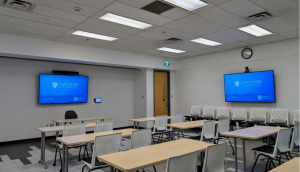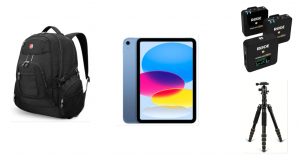Hyflex Pilot Project
An exciting new pilot project is running this Fall to investigate a mode of teaching and learning that is (officially) new to Capilano University. In the Fall of 2023, the Faculty of EHHD received funding to pursue a hyflex approach to delivering senior courses in the ECCE program to students outside of the CapU campus areas. A committee was formed along with a working group comprised of faculty with CTE support to explore this mode of delivery. At the same time, the new Digital Learning Framework established a new definition of this mode of learning for CapU:
“Classes take place simultaneously in-person and synchronous online. Students may choose, or their location may dictate, to attend in-person or online“(p.5)
While there are many definitions of Hyflex Teaching and Learning, at CapU, the intention is not to offer a parallel asynchronous stream but to focus on creating a unified classroom experience for both online and in-person students. For the purposes of the pilot, students chose when they enrolled to attend the course either in person or online. Once the course has begun, students will remain in the cohort of their choice. Half are online and half are in the classroom. A Teaching Assistant (TA) role is also being piloted to assist in keeping the online students connected to the classroom experience.
Design Principles
After reviewing the experience at several institutions including site visits or online consultations with SFU, San Francisco State University, Northern Alberta Institute of Technology and the University of Utrecht, we worked with DTS to develop a set of guiding principles that were applied to the pilot project:
- To choose a complex design challenge to ensure that we test out as many use cases as possible.
- To create an equivalent but not identical experience for both in person and online students, focused on meeting the learning outcomes of the course.
- To resist the technology’s tendency towards creating ‘spectators’ rather than active learners out of online students.
- To work with technology that is compatible with existing CapU systems and platforms.
- To avoid adding technology that creates additional teaching complexity without materially improving the student experience.
- To ensure that the best possible sound experience is included in the technology setup.
- To build accessibility into the design rather than as an afterthought.
- To incorporate student feedback and input at critical points in the design and development process.
- To identify challenges and opportunities for further development.
The pilot will be exploring three very different use cases for hyflex teaching:
Classroom Use
 The classroom experience involves lecture, discussion, small group work and demonstration activities. Some of these activities and demonstrations are quite small and detailed, using paper journals, necessitating the use of an additional camera, possibly a document camera so that the instructor can be hands free while demonstrating. Sound needs to be of the best quality possible (ideally this would include live music but Zoom room technology does not currently permit this) and microphones distributed throughout the room to facilitate discussion and active learning. Captioning and recording will be available for online students. A headset is needed to permit the TA to have conversations with the online students that are audible only for them and do not go through the speakers to the rest of the room.
The classroom experience involves lecture, discussion, small group work and demonstration activities. Some of these activities and demonstrations are quite small and detailed, using paper journals, necessitating the use of an additional camera, possibly a document camera so that the instructor can be hands free while demonstrating. Sound needs to be of the best quality possible (ideally this would include live music but Zoom room technology does not currently permit this) and microphones distributed throughout the room to facilitate discussion and active learning. Captioning and recording will be available for online students. A headset is needed to permit the TA to have conversations with the online students that are audible only for them and do not go through the speakers to the rest of the room.
Studio Use
This room is not available for general use so will be using a portable cart-based setup. In the studio there are demonstrations and small group projects going on in different sections of the room using a variety of media and tools. Some of these activities and demonstrations are quite small and detailed, necessitating the use of a document camera so that the instructor can be hands free while demonstrating. A headset is needed to permit the TA to have conversations with the online students that are audible only for them and do not go through the speakers to the rest of the room. A laptop connected to Zoom will be used for this purpose.
there are demonstrations and small group projects going on in different sections of the room using a variety of media and tools. Some of these activities and demonstrations are quite small and detailed, necessitating the use of a document camera so that the instructor can be hands free while demonstrating. A headset is needed to permit the TA to have conversations with the online students that are audible only for them and do not go through the speakers to the rest of the room. A laptop connected to Zoom will be used for this purpose.
Outdoor Use
 The outdoor classroom will take place on campus or elsewhere if cel service is available. It will involve conversations, demonstrations and activities that involve students responding to the environment around them. Additional microphone(s) will be needed to capture the ambient sound and the other students’ contributions. An iPad connected to Zoom will be used to bring online students into the conversation.
The outdoor classroom will take place on campus or elsewhere if cel service is available. It will involve conversations, demonstrations and activities that involve students responding to the environment around them. Additional microphone(s) will be needed to capture the ambient sound and the other students’ contributions. An iPad connected to Zoom will be used to bring online students into the conversation.
Stay tuned! We will be sharing our findings with the CapU community and beyond as we explore these new horizons this Fall.

Recent Comments